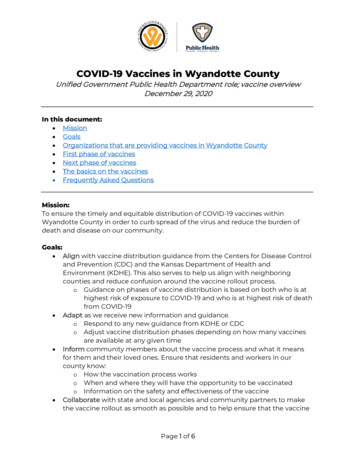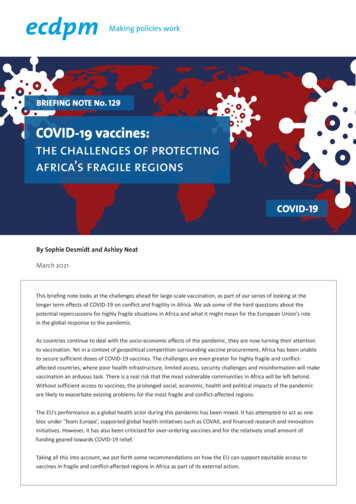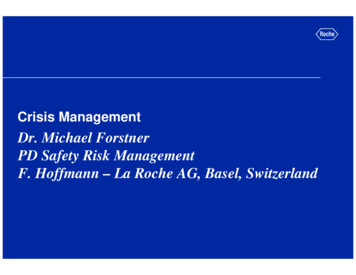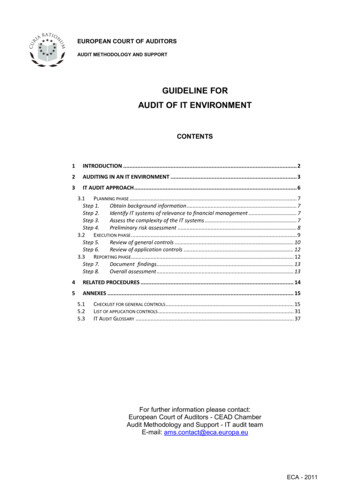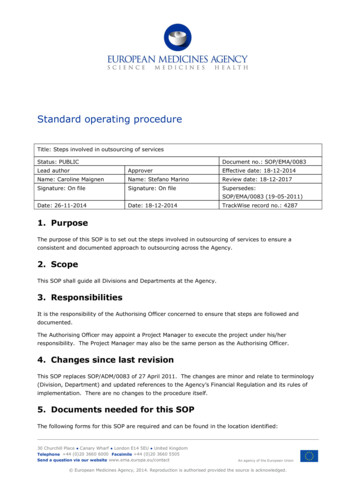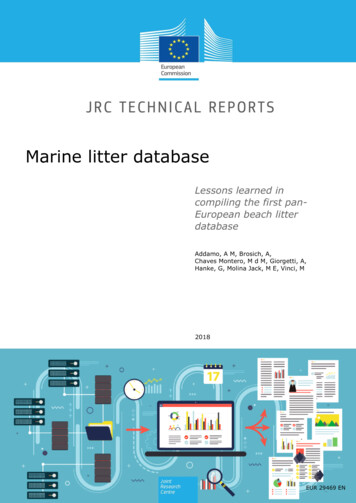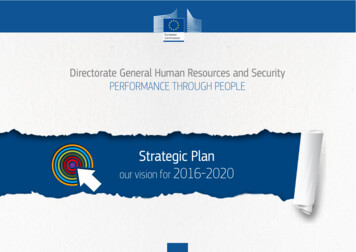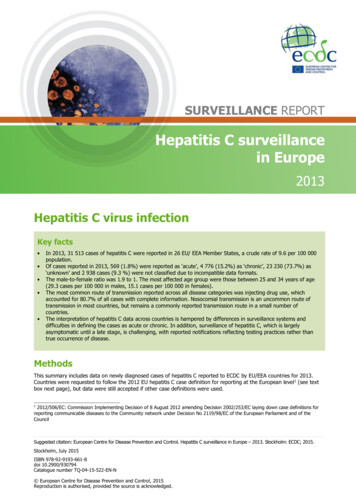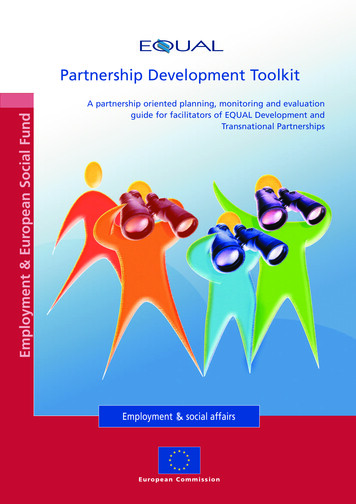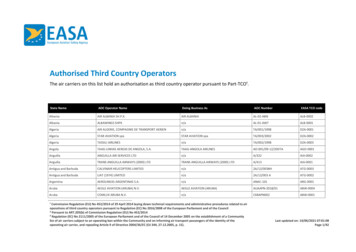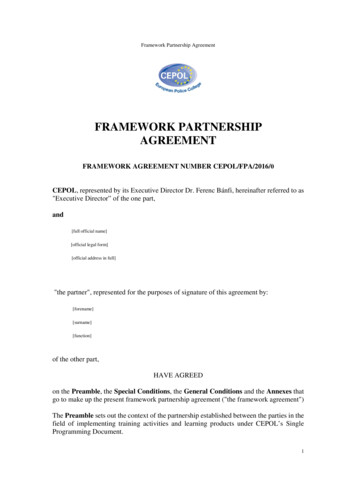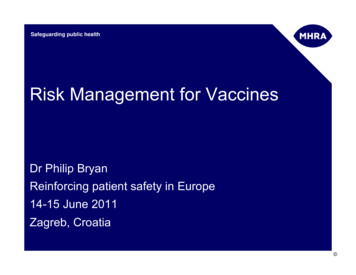
Transcription
Safeguarding public healthRisk Management for VaccinesDr Philip BryanReinforcing patient safety in Europe14-15 June 2011Zagreb, Croatia
Vaccine Risk Management –Regulatory vs Public Health function Regulatory tools defined in legislation New Pharmacovigilance Legislation will strengthen the roleof Risk Management Plans (RMPs) Regulators and industry need to ensure vaccine RMPs arefit for purpose- Legislation and RMPs are a focus of separate sessions This session focuses on strategic and scientific principles tostrengthen vaccine risk management from public healthperspective
Content Immunisation programmes and infrastructure Vaccine programme safety and effectiveness Vaccine quality and adverse events Systems to identify new risks (‘signal detection’) Approaches to evaluating safety ‘signals’ Planning for mass immunisation· E.g. Pandemic (‘swine flu’) vaccine
Why treat vaccines any different todrugs in Risk Management Planning? Vaccines (mostly) given to the healthy Perception of benefits can be low Lower tolerance of risksSerious disease rare, herd immunityGiven to large % of the population Often mass immunisation campaigns event reports Lack of comparable control groups
And ‘Generic’ vaccines do not exist Risk/Benefit balance is dynamic Temporal and geographic (e.g. oral polio)Vaccine scares can have massive impact Biological variabilityNot only on target population but on widerpopulation – resurgence of diseaseALL aspects of pharmacovigilance requirespecial considerations for vaccines
The Benefits of Vaccination After provision of clean water, vaccination is the mosteffective global public health interventionSource – ‘Green Book’Not forgetting smallpox eradication
Unfounded vaccine scares Pertussis vaccine and encephalopathy (1970s)· Resurgence in pertussis in UK MMR (and thiomersal) and autism (1990s-)· Measles outbreaks, general vaccine confidence Hepatitis B vaccines and multiple sclerosis (1990s)· Adolescent programme in France stopped Polio vaccines and contamination (contraceptives, HIV )· Hindered the global eradication campaign (Africa)
The Challenges Rapidly identifying and evaluating potential risks Providing targeted and tailored information- Explaining the science and nature of data- Communicating benefits and safety Promoting confidence in safety surveillance systems,and thereby the vaccine programme
Immunisation Programmes Effective Risk Management planning for vaccinesrequires an understanding of:····the (national) immunisation programmethe (national) regulatory, policy and clinical frameworkthe infrastructure for delivery of the programmethe various stakeholders and their needs These aspects are broadly consistent between countries However, immunisation schedules can differ widely· Safety profile (and R/B) of individual vaccines maydiffer as a consequence
Vaccine programme stakeholders Public health authority (including Govt) Disease surveillance networks Regulatory authority Batch release authority (OMCL) Healthcare professionals and healthcare delivery systems The public and the media Pharmaceutical industry
Immunisation Schedules Schedules are invariably dynamic-novel vaccines and combinationsnew vaccine brands, antigens, timingdisease prevalencerisk vs benefit (e.g. live vs inactivated polio vaccine)vaccine availability and supply· All could impact on safety· Need for constant, proactive horizon-scanning· anticipate changes· have risk management plans in place in advance
Product safety vs Programme safety All vaccines carry intrinsic, product-specific risks- Vaccine antigens or excipients/adjuvants- Host factors- Biological variation/quality defects Need effective systems to identify, evaluate andcommunicate such risks- includes rapidly distinguishing possible cause from likelycoincidence However, risk management must also focus on the safety ofthe vaccine programme
Programme-related events Sepsis due to contaminated needles/vialsCold chain breakdownPoor injection techniqueFaints/panic attacks due to fear of needleUser error- All avoidable with good training and infrastructure Complexity of schedules means that mistakes do happen Need to monitor and minimise errors
Programme related event – example Packaging· Similar brands and packaging in same programme· Admin error reports, potential for safety/efficacy issue· Need to horizon scan such issues in plans
Vaccine efficacy and effectiveness Efficacy evaluated in pre-licensure trials- Protective efficacy, i.e. protection against the disease· Not always feasible or necessary- Immunogenicity· Correlates of protection· Antibodies, T cells, other surrogate endpoints· E.g. pre-cancerous lesions for HPV vaccines Effectiveness- ‘Real-life’ use as part of a programme- Effect of concomitant vaccines and disease burden- Requires national coverage and disease surveillance data
Vaccine failures Few, if any, vaccines are 100% effective Vaccine failure is also a safety issue since target diseasesare serious- Primary failure – poor/none response to initial course (e.g.5-10% failure of first dose measles)- Secondary failure – protection wanes over time (need forboosters) Generally defined as confirmed infection due to vaccineantigen/serotype, following full primary course, 7 daysafter last priming/booster dose
Effectiveness of the programme Need systems to monitor effectiveness (includingvaccination failures) Often part of national disease surveillance programme· requires close links between regulators and publichealth bodies/disease surveillance networks New EU pharmacovigilance legislation - opportunity foreffectiveness evaluation to be core requirement in RMP· will strengthen post-authorisation R/B assessment· Industry may not have routine access to the datarequired for this· Regulators/public health bodies will need to facilitate
Vaccine quality Manufacturing changes, associated biological variation andquality defects inherent risk with vaccines Risk Management Systems must monitor and assesspotential clinical consequences Requires close links between regulators and officialmedicines control laboratories (OMCLs) Batch identification and traceability critical
Vaccine safety pre-licensure EMA Note for guidance on the clinical evaluation of vaccines(CHMP/VWP/164653/2005) Defined list of solicited local (e.g. injection site ADRs) andsystemic events (e.g. fever, headache, nausea)· ‘reactogenicity’ As a minimum, trials powered to assess reactogenicity at afrequency 1,1000 Unsolicited serious events (SAEs) – cannot assess causality RMP must have plans to evaluate any SAEs of concerns
Vaccine safety post-licensure Key steps in pharmacovigilance-Data collectionSignal detectionRisk assessmentRisk-benefit evaluation/Expert adviceAction (regulatory/other)Communication Broad principles and methods no different to medicines- However, well co-ordinated immunisation programmesprovide opportunities for tailored, proactive riskmanagement
Data collection Passive surveillance- E.g. UK Yellow Card Scheme· All vaccines and medicines Pros and Cons····Real-time, rapid, permanentCan detect very rare risksUnder-reporting, subject biasesFormal studies required to confirm and quantify a riskBUT, very often the only data available and judgementshave to be made on passive data alone
Signal detection - Enhanced passivesurveillance (1) Address limitations and focus on strengths of passive data- Power to identify very rare events- Reduce under-reporting (stimulate/encourage reporting,involve patients/parents, improve access to reporting)- Make it real-time (e.g. web-based) Obtain near real-time estimates of vaccine exposure- E.g. local/national public health authorities- Stratify by age/risk group
Signal detection - Enhanced passivesurveillance (2) Utilise population-based incidence data (e.g. GPRD)- Derive age/gender-stratified data on incidence of medical‘events of interest’ from historical cohorts Combine these 3 data sources to:- Optimise value of passive data in signal detection- Help to rapidly communicate such data in the context of‘expected’ background events‘Observed vs expected’
‘Observed vs expected’ ‘Real-time’ surveillance· Establish the ‘expected’ per N doses· Compare reporting rate to expected incidence· Adjust for multiple, daily statistical testing (e.g.Maximised Sequential Probability Ratio Test(MaxSPRT)· Adjust for variable under-reporting Case definitions· Validated and standardised· Allow comparisons across countries and pooling· E.g. Brighton Collaboration
Risk Assessment In a few instances, can have confidence in causalassociation based on individual reports/clusters:Injection site eventsImmediate hypersensitivityIsolation of vaccine virus (live) in body tissuesEvent very similar to natural infection (live vaccines –need to exclude wild virus)· Cluster of onset times (if reporting bias excluded)···· But, majority of new events/signals will have unknown/ill-defined aetiology or occur naturally in population· For most new signals of serious risks, formalstudies required to assess causal association
Study approaches Issue for routine vaccines is high exposure· lack of an appropriate (if any) control group· reasons for non-vaccination (or vaccination) associatedwith outcome – e.g. socio-economic status, healthstatus when vaccine was due E.g. DTP vaccine and SIDS· Most case control/cohort studies show protectiveeffect - ‘healthy vaccinee’ CC/cohort method still applicable for routine vaccines withsuitable controls and adjustment- But, case-only methods offer alternative approach
Case only approaches Self-controlled case series, Case-crossover, Risk-interval analysis· Rapid and relatively inexpensive· Need only cases - cases act as their own controls· Most individual-level confounders automatically adjusted· Identify a series of ‘control’ periods before/after ‘risk window’ Issues:· Need to define a plausible risk period· Not always easy to define – can be unknown· Short (e.g. febrile seizure) or long (e.g. MS, autism)· Precise onset of illness required· Easy for e.g. GBS, facial palsy· Difficult with insidious onset – e.g. MS, CFS
Other approaches Active surveillance· Limited utility for rare, serious risks Ecological studies· Groups rather than individuals· Rapid, inexpensive· Associations at an individual level not necessarilyreplicated at group level Phased geographical vaccine introduction· E.g. cluster randomised trial· Often not feasible on public health/ethical grounds
Planning and implementing a newvaccine risk management strategy Understand full safety specification (from RMP)· Identify key risks and/or gaps Understand when and how programme will be implemented····Target GroupImmunisation scheduleNumber in cohort – number of dosesWho will administer – primary care? schools? Anticipate and plan for the issues likely to arise· Look at the vaccine· Look at similar vaccines· Look at prior experience in similar populations
Pandemic ‘swine flu’ H1N1v vaccine Planning in place for several years (bird flu?) Novel vaccines (monovalent, adjuvanted)- ‘mock-up’ licence process- pre-licensure safety database very limited Planned for reasonable worst case scenario····Mass immunisation campaignPressures on healthcare system and resourceImpact on national infrastructure (e.g. post)Business continuity
April/May 2009 .
.July 2009 .
European Medicines Agency strategy EMA Crisis Management Plan implemented-core RMPs (simplified PSURs, PASS study etc)EMA co-ordinated EU pharmacovigilance activitiesWeekly safety updates (ADRs, exposure, EV analysis)Pandemic Rapid Response Expert Group (PREG)ECDC liaison Encouraged use of ‘observed vs expected’ in signaldetection and analysis
UK Enhanced passive surveillance Optimisepassivereporting On-line Fully automated- Large volumeof ADRs- resilient tobusinesscontinuitypressures Daily analysis
UK observed vs expectedBackground conditions per 4 million doses* for ‘adverseevents of interest in defined population groups (e.g.adolescents immunised in school)Bell’s palsyEncephalitisGuillain-Barré SyndromeChronic Fatigue SyndromeCoeliac diseaseGlomerulonephritisHaemolytic anaemiaMultiple SclerosisMyasthenia GravisMyelitisSystemic lupus erythromatosusIncidence rate /100,000 / 0‘Expected’ within .2825.42
UK observed vs expected – Guillain BarreSyndromeMaximised SPRT for Guillain-Barre Syndrome for patients aged 65 years2018Critical value10% events reported1625% events reported50% events reported75% events reported14Log Likelihood Ratio100% events Week100%75%50%25%
Communication – Public Assessments Weekly, proactive andtransparent Assist interpretationof passive data Give public a balancedoverview of safety Minimise mis-use ofdata by media- Get in first, Create our own headlines
CONCLUSIONS Need to continually horizon-scan for changes inimmunisation programme and anticipate likely issues basedon past experience· Proactive and tailored vaccine risk managementstrategies should be planned well in advance Need to optimise data collection and make best use of allavailable data sources Communications should be balanced, taking account of thevariety of stakeholders in vaccine safety Risk Management Plans will become an increasinglyimportant regulatory tool to evaluate balance of risks andbenefits in a real-life setting
Guidelines and further reading European Medicines Agency Vaccine PhV guideline- Sep 2008 – Doc. Ref. EMEA/CHMP/PhVWP/503449/2007 WHO Global Advisory Committee on Vaccine Safety (GACVS) -www.who.int/vaccine safety/en/ Brighton Collaboration -www.brightoncollab
risk vs benefit (e.g. live vs inactivated polio vaccine)-vaccine availability and supply · All could impact on safety · Need for constant, proactive horizon-scanning · anticipate changes · have risk management plans in place in advance
